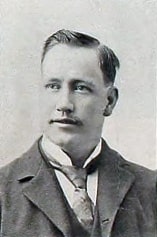Origins of Volleyball

Volleyball, a sport now played and loved by millions across the globe, began as a modest indoor game designed to provide a less physically demanding alternative to basketball.
Its inception is attributed to William G. Morgan, a physical education instructor at the Young Men’s Christian Association (YMCA) in Holyoke, Massachusetts, USA. Born out of necessity, volleyball was created to accommodate older participants in Morgan’s fitness classes, offering a game that blended elements of other popular sports but with less intense physical contact.
The Birth of Volleyball: William G. Morgan’s Innovation (1895)
In 1895, William G. Morgan was overseeing physical fitness classes at the YMCA, a period during which basketball, invented four years earlier by Morgan’s friend James Naismith, was rapidly growing in popularity.
However, Morgan noticed that basketball, with its fast paced, high energy gameplay, was too strenuous for many of the older, less athletic members of his classes. Looking for a solution, he sought to create a new sport that would still be stimulating, but not as physically taxing.
Morgan’s vision combined aspects of several sports: basketball’s basic court structure, tennis’s net, baseball’s concept of innings and elements from handball. This unique mixture culminated in a game initially called “Mintonette.”
It featured a net placed six feet six inches high, slightly lower than a standard tennis net but much higher than the hoops of basketball. The objective of the game was simple: to keep the ball in motion from one side to the other by volleying it back and forth over the net without allowing it to touch the ground.
The early version of the game included an unlimited number of players and lacked the rigid structure that modern volleyball eventually developed. A point was scored only when the opposing team failed to return the ball and the game continued until a specific number of innings, similar to baseball.

The Name “Volleyball” and Early Rules (1896)
The transformation from “Mintonette” to “volleyball” happened relatively quickly. During a demonstration of the game at the YMCA in 1896, someone observed that the action of volleying the ball over the net was the sport’s most distinctive feature, prompting the suggestion to rename the game “volleyball.” This name captured the essence of the sport far more effectively than “Mintonette.”
The early rules, as developed by Morgan, were basic yet functional. The game was played with a basketball bladder, which was later replaced by a specially designed volleyball. The court was originally 25 by 50 feet and each team could have any number of players. The net was slightly higher than the waist of an average player, promoting a balanced competition between skill and power.
Initially, the game could continue indefinitely as there was no specific time limit or scoring cap, except for innings. While these early rules allowed for flexibility and were open to modification by different YMCA locations, they lacked the precision that later revisions would introduce.
Spreading the Game: YMCA’s Role in Volleyball’s Early Growth
The YMCA played a significant role in the rapid spread of volleyball, both within the United States and internationally. As an organization dedicated to promoting physical fitness and community engagement, the YMCA had a vast network of branches across the country and overseas.
These branches enthusiastically adopted volleyball as part of their fitness programs, seeing it as an ideal activity for people of all ages and skill levels.
By the early 1900s, the YMCA’s influence had helped spread the game to countries like Canada, Cuba, Puerto Rico and even parts of Asia, including China and Japan. The game’s accessibility and simplicity contributed to its popularity abroad.
Moreover, the international YMCA training school and missionary networks introduced volleyball to various countries where it soon became a favorite pastime.
Volleyball’s international appeal was bolstered by its adaptability. Different countries could modify the rules to suit their local preferences and capabilities, making the game feel approachable to newcomers. The sport’s minimal equipment requirements also made it easier to implement in less developed areas, further increasing its global reach.
Refining the Rules: The Establishment of the Official Guidelines (1920s–1930s)
As volleyball gained popularity, the need for a standard set of rules became apparent. In the 1920s, official rules began to solidify, including the introduction of team sizes and a points system.
A major revision during this period was the reduction in the number of players per team from unlimited to six, which led to the creation of the “6-a-side” format that remains the standard in the modern game.
In addition, the “three hits per side” rule was introduced, which dictated that each team could touch the ball up to three times before returning it over the net. These rules refined the pace and strategy of the game, adding more structure and competitiveness.
Around this time, volleyball started gaining traction at schools and colleges, which helped nurture younger talent and further cemented the game’s role in the athletic community. Intercollegiate competitions soon began and volleyball’s inclusion in physical education curricula laid the foundation for future growth.
The Role of the Armed Forces and Global Expansion (World War I & II)
World War I played a crucial role in the spread of volleyball beyond YMCA networks. American soldiers brought the game with them to Europe during the war, introducing it to a whole new audience. By the end of the war, volleyball had established a significant presence in Europe.
The sport’s popularity among soldiers continued during World War II and the U.S. military officially adopted volleyball as a recreational activity for troops stationed overseas. This further extended the game’s reach, especially in countries like Italy, France and Germany.
After World War II, volleyball experienced explosive growth in Europe, Asia and South America. Japan, the Philippines and Brazil quickly emerged as major hubs for the game, developing distinct regional styles and increasing the sport’s overall competitiveness.
Formalization and the Birth of International Competitions (1940s–1950s)
The formalization of volleyball at the international level began in 1947 with the founding of the Fédération Internationale de Volleyball (FIVB). The FIVB was instrumental in organizing the first men’s World Championship in 1949, followed by the women’s competition in 1952.
These international tournaments helped raise the profile of the sport, giving it a stage on which to develop and showcase talent from different countries.
Volleyball’s inclusion in the Pan American Games in 1955 and its subsequent entry into the Olympic Games in 1964 further solidified its place as a premier global sport.
Conclusion: From Humble Beginnings to a Global Phenomenon
From a humble YMCA gymnasium in Massachusetts to the grand stages of the Olympics, volleyball has undergone a remarkable transformation. Its origins as a friendly, accessible game designed to serve a specific demographic gave way to a sport that has become a symbol of athleticism, teamwork and international unity.
Volleyball’s development over the years has been marked by its adaptability, its growing complexity through the refinement of rules and the role of institutions like the YMCA and the military in spreading its popularity.
Today, volleyball is not only a testament to Morgan’s innovative spirit but also a global phenomenon, uniting people across different cultures, nations and generations.


